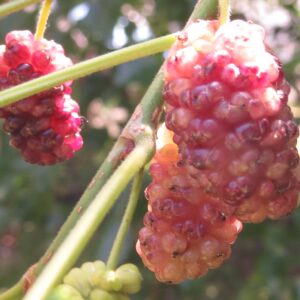Illinois Everbearing Mulberry
The standard by which all other cold-hardy mulberries are measured. Yields large crops of exceptionally flavored mulberries over the course of 2-3 months, is one of the cold-hardiest mulberries available and can be kept smaller with regular pruning.
Be aware that is warmer climates, “Illinois Everbearing” is highly susceptible to popcorn disease and can lose its entire crop.
Grafted onto Morus rubra (native Red Mulberry)
Spacing: 15-20 foot radius if not pruned; 10 foot radiius if kept pruned
USDA Zone 4b-8 (though some say 9)
Morus alba x rubra
Discovered in Illinois as a chance seedling by Peter Glaser in 1947, “Illinois Everbearing” has become one of the most popular cultivars of mulberries in the US and has set the standard by which all other mulberries are measured. Not only is it considered one of the most adaptable and cold-hardy cultivars of mulberry, it is also diverse in how it can be grown due to its semi-dwarfing growth habit; It can be allowed to get full size (15-20 feet) or it can be kept as a smaller bush with routine pruning. Beyond these special characteristics, the tree also boasts reliable yields of copious amounts of large, sweet, exceptionally flavorful berries over the course of 2-3 months. There is little this tree can’t offer which is why it has gained so much popularity in the last 7 decades.
Be aware that is warmer climates, “Illinois Everbearing” is highly susceptible to popcorn disease and can lose its entire crop.
Grafted onto Morus rubra (native Red Mulberry)
Spacing: 15-20 foot radius if not pruned; 10 foot radius if kept pruned
USDA Zone 4b-8 (though some say 9)






Reviews